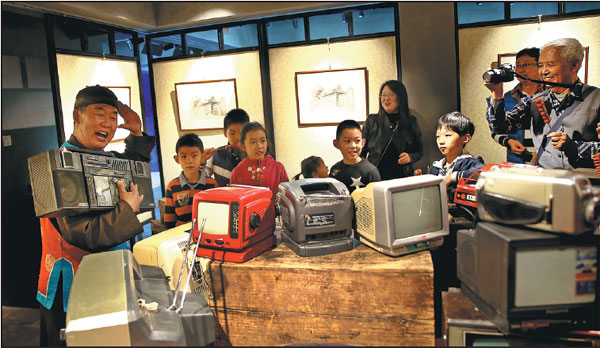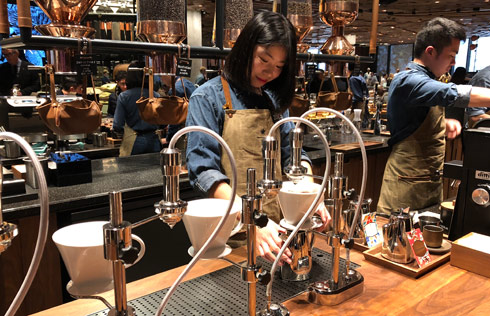Exhibition jogs nation's collective memory
Display of outdated objects illustrates the progress made since reform and opening-up was adopted. Zhao Yimeng reports.
Editor's note: This is the last story in a series reflecting China's achievements in a range of fields, including science, law enforcement, education and transportation, resulting from 40 years of the reform and opening-up policy.

Surrounded by obsolete objects, Song Zhenzhong, a small man in a red traditional jacket, excitedly explained how to operate the "antiques" to a group of primary school students.
That was in October, when Song held an exhibition of outdated objects at a library in Beijing's Dongcheng district. Daily necessities marking changes in China, ranging from rice coupons to black-and-white televisions, were displayed to illustrate the advances that have occurred in the past 40 years.
For older observers, the objects brought back memories, while the younger ones enjoyed an eye-opening glimpse of the past.
Song's event was one of several he has held this year to mark the 40th anniversary of the reform and opening-up policy.
The 55-year-old is a sixth-generation descendant of the Manchu Eight Banners, an administrative division of the Qing Dynasty (1644-1911), in Beijing.
His parents made a living by dipping strings of candied haws in sugar and selling them on the streets. Having learned the tricks of the trade, Song helped his parents in their work and excelled at peddling the candies.
He started collecting curios as a hobby at age 13, and now owns four museums that contain items such as bronze mirrors and headwear dating from the Qin Dynasty (221-206 BC) to the Qing. The exhibition in October, which centered on objects related to people's daily lives, was one of more than 10 events he has held this year to display his vast collection.
"It's meaningless to deliver lectures via computers because it is not perceptual at all. These outmoded objects, which appeared after the 1970s, are just a small part of my collection. As someone who grew up in a traditional Beijing alleyway, I want to make a contribution to traditional culture and leave something for my descendants," he said.
The internet has made it easy for collectors to obtain discarded former necessities.
Food coupons
In the days when China operated a planned economy, people used a variety of coupons to obtain everything from food to appliances.
Food coupons were among the first batch of negotiable securities issued by the government. From the 1950s to the '80s, a period of severe shortages, the coupons ensured that every family received its fair allocation of food.
"My grandfather and I waited in line to buy rice coupons on the 24th of each month with the salary my mom got the same day. We had to allocate the rice carefully or we wouldn't have enough to eat," said Wang Yuxia, a 60-something who grew up in Beijing.
"The monthly supply was recorded in a notebook that showed the amount of rice and oil each family bought. Four of us ate 59 kilograms a month," she added, noting that the entries end in June 1993.
As living standards improved - the per capita disposable income of urban residents rose to 25,974 yuan ($3,770) last year from 171 yuan in 1978 - rice coupons gradually disappeared from daily life.
"Cash replacing coupons as a form of payment was not a sudden change but a gradual process. I remember using rice coupons and cash together to buy food," Wang said.
"Now we buy goods via mobile payment. I can buy groceries without taking cash with me when I walk around after dinner. It's far more convenient than using rice coupons."
A recent report from the National Bureau of Statistics shows that China's Engel coefficient, a measure of food expenditure as a proportion of total household spending, fell to 29.3 percent last year, nearly 35 percent lower than in 1978, indicating the rise in living standards.
Higher living standards
Four decades of reform and opening-up have seen higher living standards and helped China to become the world's second-largest economy.
The NBS said GDP has risen from 370 billion yuan in 1978 to almost 83 trillion yuan last year.
According to people.cn, the annual growth rate was 14.5 percent, and last year, China accounted for 16 percent of the global economy, compared with 1.8 percent in 1978.
Transportation
Li Yan, a 45-year-old consultant in the field of information and communications technology in Beijing, was among the visitors at Song's exhibition. "Foreign products flowing into the country had a huge impact - boosting innovation, both in products and ideas," she said.
Reflecting on the most impressive change for her in the past 40 years, Li plumped for the improvement in the transportation network.
"Back in my school days, we used student tickets when we took a bus to school, but they only arrived every 30 minutes in the morning. The infrequent, crowded buses made attending school very difficult," she said.
During the past four decades, transportation payment systems were upgraded from paper tickets to travel cards, and today smartphone apps provide convenience when using public transportation.
Public vehicles have improved, too. Last year, Beijing Public Transport owned and operated 26,363 public vehicles, compared with 3,315 in 1978. Moreover, 739 routes have been added to the 119 that operated in 1978.
Li said that when she first visited Europe 20 years ago, she was shocked by the advanced subway and high-speed rail networks.
"However, I recently returned from a business trip to Italy. My assistant asked me not to tease her about their subway systems. She was worried that people from China would find the networks old-fashioned because China's rate of development is much faster," she said.
Visitors to Song's exhibition stopped to view items that caught their eye, especially those connected to their younger selves.
A dusty abacus in a corner attracted the attention of accountant Yin Mingxian. Though computers and mobile phones are universally popular nowadays, the simple counting frame invented during the Song Dynasty (960-1279) is still used because of its accuracy and convenience.

"When I started my first job in the 1990s, we had had calculators, but I still used an abacus because I regarded it as much more accurate," she said, with a laugh. "Veteran accountants preferred the old-fashioned abacus in particular. Today all companies use computers to do their accounts."
The Chinese abacus, zhusuan, was listed as an intangible cultural heritage at the eighth annual UNESCO World Heritage Congress in 2013.
Yin's son, who was born in 1995, showed little interest in his mother's work items, but he could not take his eyes off several tape recorders.
"We listened to tapes in English class, like all children at the time," he said.
His peer, Li Yimeng, a 20-something who has just gained a master's, has a special feeling for tapes and recorders: "The tapes matched my Chinese and English textbooks, and I listened to them every day during middle school."
In 1963, the role of tapes was expanded from data storage to playing music, and they were later replaced by MP3, MP4 and mobile phones.
"I can recall the lyrics and text shining on the screen of the MP3 and MP4 players as I listened to music and read stories from textbooks," Li Yimeng recalled.
"Now, all you need is a smartphone, which gives everyone access to learning materials anywhere. People don't have to sift through tapes and play them in order, which saves time. As technology progressed rapidly, tape recorders faded out of our lives," she said.
A taste from childhood
During the exhibition's opening ceremony, visitors were each given a string of candied haws made by Song to revive a favorite childhood taste.
However, he wasn't trying to show off his skills by filling the room with fragrant smells and sweet flavors. Instead, he simply wanted to attract more children to the event so they could see the redundant items.
"I don't feel privileged about my family background, and I have never thought of making a fortune from my collection. I love traditional culture and my original inspiration was to spread it by collecting as many old-fashioned objects as possible and showing them to people to illustrate the country's rich culture," he said.
Contact the writer at zhaoyimeng@chinadaily.com.cn
|
Song Zhenzhong (left), a collector of outmoded objects, displays his collection at an exhibition in Beijing in October.Zou Hong / China Daily |
(China Daily 01/02/2019 page5)



















